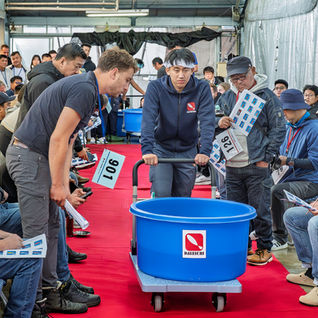Tosai Culling: Separating the Great from the Good
- Kevin Warren

- Apr 16
- 3 min read
Updated: 5 days ago
Tosai, a year-old Nishikigoi, are born in approximately June using indoor ponds and techniques developed by Nishikigoi breeders. After birth, young fry are separated and placed in outdoor “mud ponds” for the summer, where they grow up to approximately 25 centimeters (9 inches).
Statistical Example:
1st stage of culling with Go-Sanke variety, approx. 4-5% of the fry are moved into the mud ponds to keep growing.
As winter approaches, mud ponds are emptied in October, and all koi are moved to indoor ponds at the Breeders’ farm. These young Nishikigoi are placed in ponds maintained at the optimal temperature for their growth and helath, around 26 degrees Celsius (79 Fahrenheit). Quality food, calculated in precise quantities, Pristine water, and the frequency of feedings are also crucial.
As March arrives in Koi Farms across Japan, it is time to commence the Tosai culling process. While the objective remains the same for all breeders, each employs their unique methodology, style, and procedures to accomplish the task.
Large seining nets are gently maneuvered in the ponds to gather the yearling koi, which are then placed in bowls outside the pond using smaller scooping nets for selection. The selection process can take several hours or even days, depending on the size of the Koi Farm and the number of Tosai to be culled. Larger farms may have thousands or tens of thousands of Nishikigoi Tosai to separate. Patience is paramount during this process.

Breeders carefully assess the body conformation of the koi, seeking balance, strength, and symmetry. They then pay attention to color and patterns, envisioning how each koi’s colors will mature over the next few years. Vibrant reds, deep sumi blacks, and pristine whites may indicate potential greatness, although subtle shifts in color can still significantly alter the fish’s future. The culling process is not about rejection but rather about recognition.
Statistical Example:
At the end of the growing season approx. 0.2% are harvested as Tategoi Tosai. "Tategoi Tosai" refers to Tosai koi that are considered to have the potential to grow into beautiful and valuable adult Tategoi
The most exceptional Tosai are then moved into their own ponds, where they are meticulously cared for to enhance their natural beauty. Further culling will continue until only the finest specimens remain, separated again into a special pond, representing the best of the hard work and dedication of their breeders.

The remaining koi are not forgotten or discarded; they will receive the same love and care as the finest koi and will continue to thrive in ponds worldwide. It is important to recognize that there are only a limited number of Show-winning Koi that are truly exceptional. Consider this analogy to athletes. The world’s most accomplished athletes are Olympians, football champions, and individuals who have achieved global recognition. However, beneath these exceptional athletes lie millions of highly talented competitors who dedicate their lives to their sport, competing in leagues and arenas across the globe.
I hope that your pond is fortunate enough to house at least one of these extraordinary, best-of-the-best Nishikigoi. If not, take pride in the fact that you have koi that you love and enjoy observing and caring for. After all, the presence of koi, the soothing sound of water, and the beauty of a garden can significantly enhance the quality of life.
Reference
Tosai (one-year-old koi):
These are young koi that are still developing their colors, patterns, and overall form.
Tategoi (koi with potential):
This term is used for koi that are being raised with the expectation that they will continue to improve and become a prize-winning fish.
Combining the terms:
"Tategoi Tosai" emphasizes the concept of buying a one-year-old koi based on its lineage and future potential, rather than solely on its immediate appearance.
Clockwise from top left: NND tosai swimming in indoor pond. Ryu Mano, Izumiya Koi Farm selecting tosai.
Tamikazu Kobayashi, NND separating tosai with a nod to the Nishikigoi god's. Marudo Koi Farm crew separating tosai. Ryu Mano, Izumiya Koi Farm tossing a tosai into one of his ponds. All Photos: Kevin Warren
















